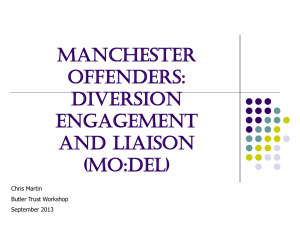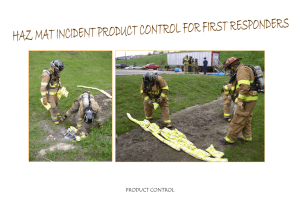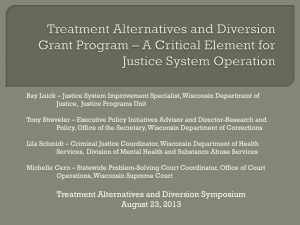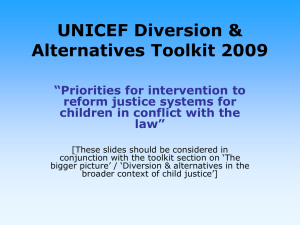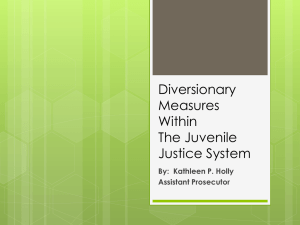2013-04-13 - Sustainability
advertisement
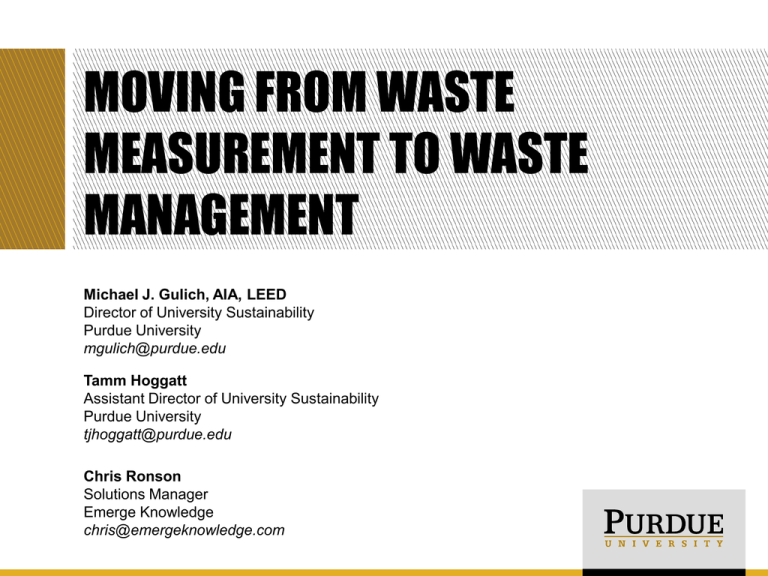
MOVING FROM WASTE MEASUREMENT TO WASTE MANAGEMENT Michael J. Gulich, AIA, LEED Director of University Sustainability Purdue University mgulich@purdue.edu Tamm Hoggatt Assistant Director of University Sustainability Purdue University tjhoggatt@purdue.edu Chris Ronson Solutions Manager Emerge Knowledge chris@emergeknowledge.com IF YOU CAN’T MEASURE IT, YOU CAN’T MANAGE IT. - Peter Drucker 2 PURDUE UNIVERSITY WEST LAFAYETTE CAMPUS Approximately 40,000 students and over 15,000 faculty and staff 381 buildings on campus in West Lafayette, IN Land grant college founded in 1869 3 PURDUE UNIVERSITY SOLID WASTE MANAGEMENT 4 PURDUE UNIVERSITY SOLID WASTE MANAGEMENT PHILOSOPHY Single-stream (for the most part) Separate streams for: Office paper (includes confidential paper) High-volume producers of cardboard CARDBOARD 13% OFFICE PAPER 24% COMMINGLED RECYCLABLES 63% 5 PURDUE UNIVERSITY SOLID WASTE MANAGEMENT PHILOSOPHY Trash cans removed from all desks in 2009 – went from trash pickup 3x/week to recycling pickup 2x/week 5,500 recycling containers in residence hall rooms Narrow definition of landfill trash (academic core): Food waste Napkins and tissues Restroom hand towels 6 PURDUE UNIVERSITY GOALS OF THE PROGRAM Maximize Purdue’s diversion rate by the most costeffective and efficient means Reduce the amount of waste currently landfilled Raise Purdue’s diversion rate to 85% by 2014 85% BY 2014 DIVERSION RATE WHAT IS DIVERSION RATE? Diversion rate is calculated as: Total Recycling Collected x 100 Total Waste Generated (Recycling Collected + Landfill Trash) Expressed as a % 8 DIVERSION RATE PURDUE’S DIVERSION RATES Traditional Diversion Rate (50% for 2011-12) Institutional Diversion Rate (80% for 2011-12) Reported to the public 85% target by 2014 Comprehensive Diversion Rate (91% for 2011-12) Recyclemania Diversion Rate (36% for 2012) Game Day Challenge Diversion Rate (18% for 2012) 9 DIVERSION RATE TRADITIONAL DIVERSION RATE Traditional Diversion Rate (50% for 2011-12) 10 DIVERSION RATE TRADITIONAL DIVERSION RATE Diversion Rate (%) 60.0% 50.0% 40.0% 30.0% 20.0% 10.0% 0.0% 94-95 95-96 96-97 97-98 98-99 99-00 00-01 01-02 02-03 03-04 04-05 05-06 06-07 07-08 08-09 09-10 10-11 11-12 Diversion Rate (%) 11 DIVERSION RATE INSTITUTIONAL DIVERSION RATE Institutional Diversion Rate (80% for 2011-12) 12 DIVERSION RATE COMPREHENSIVE DIVERSION RATE Comprehensive Diversion Rate (91% for 2011-12) 13 DIVERSION RATE NATIONAL STANDARDS No national standard for what is in the diversion rate AASHE STARS (v1.2) OP Credit 18: Waste Diversion – materials destined for disposal in a landfill or incinerator but diverted by recycling, composting, reuse, donation, or resale – does not include construction, demolition, electronic, hazardous, special, universal and nonregulated chemical waste OP Credit 19: C&D Waste Diversion OP Credit 20: Electronic Waste Recycling 14 LANDFILLED MATERIAL ALTERNATIVE METRIC 9000 8000 7000 Total Waste in Tons 6000 5000 Series2 4000 Series1 3000 2000 1000 0 94-95 95-96 96-97 97-98 98-99 99-00 00-01 01-02 02-03 03-04 04-05 05-06 06-07 07-08 08-09 09-10 10-11 11-12 Fiscal / Academic Year 15 WASTE AUDITS RESIDENCE HALLS Cary Quad – Floor 3 10% Landfill | 90% Recycling 16 WASTE AUDITS RESIDENCE HALLS Cary Quad – Floor 4 5% Landfill | 95% Recycling 17 WASTE AUDITS RESIDENCE HALLS Harrison Hall 10% Landfill | 90% Recycling 18 WASTE AUDITS RESIDENCE HALLS Meredith Hall – Floor 3 10% Landfill | 90% Recycling 19 WASTE AUDITS RESIDENCE HALLS Harrison Hall 50% Landfill | 50% Recycling 20 WASTE AUDITS SHREVE HALL | ECO-REPS 21 WASTE AUDITS SHREVE HALL | ECO-REPS 22 WASTE AUDITS RAWLS HALL | LEED-EB:O+M 23 WASTE AUDITS RAWLS HALL | LEED-EB:O+M 24 RECYCLEMANIA OPPORTUNITY FOR NEW DATA No national standard for what is in the diversion rate AASHE STARS (v1.2) OP Credit 18: Waste Diversion – materials destined for disposal in a landfill or incinerator but diverted by recycling, composting, reuse, donation, or resale – does not include construction, demolition, electronic, hazardous, special, universal and nonregulated chemical waste OP Credit 19: C&D Waste Diversion OP Credit 20: Electronic Waste Recycling 25 RECYCLEMANIA 26 RECYCLEMANIA RECYCLE MADNESS RESULTS Landfill Trash During Recyclemania University Residences 51% Academic Campus 49% Diversion Rate During Recyclemania University Residences = 24.45% Campus Average = 38.51% Academics Campus = 52.57% 60.00% 50.00% 40.00% 30.00% 20.00% 10.00% 0.00% University Residences Campus Average Academic Campus 27 GAME DAY CHALLENGE ALCOA FOUNDATION ACTION TO ACCELERATE GRANT 28 GAME DAY CHALLENGE ALCOA FOUNDATION ACTION TO ACCELERATE GRANT Year 1 (2012) Target = 20% diversion rate Year 2 (2013) Target = 50% diversion rate 15.1% Tailgate Diversion Rate 2012 Season 11.8% 11.4% 7.6% 18.3% 7.4% 5.3% Eastern Kentucky Eastern Michigan Marshall Michigan Wisconsin Penn State Indiana 29 SEARCH FOR DYNAMIC TRACKING TOOL NEEDS FOR TRACKING TOOL Real time tracking – not end of year Monthly data Trending analytics Simplify reporting on campus One source of data Eliminate multiple spreadsheets Departments to have ownership of their waste stream data and to have access to analytics (peer pressure) Scalable 30 SEARCH FOR DYNAMIC TRACKING TOOL EVALUATION CRITERIA FOR TRACKING TOOL SELECTION Are all of Purdue’s waste streams supported? How many users are supported? What is level of security / are there administrator rights? What analytics / reporting are available? Is customer support provided during piloting & setup? Can it track Purdue’s historical diversion rates? Can users edit data entry ‘tickets’? Is who entered the data tracked? What does the package cost? Is it user friendly? 31 RE-TRAC CONNECT PILOT PHASE 32 RE-TRAC CONNECT PILOT PHASE 33 RE-TRAC CONNECT TRAINING & IMPLEMENTATION Departments trained to-date: Grounds Gravel Pit Operation Materials Management & Distribution Warehouse & Surplus Radiological & Environmental Services Departments to be trained: University Residences Physical Facilities Purdue Memorial Union (PMU) Food Stores Smith Hall (academic butcher shop) Wade Power Plant Transportation Services 34 RE-TRAC CONNECT TRAINING & IMPLEMENTATION 35 RE-TRAC CONNECT ANALYTICS 36 RE-TRAC CONNECT ANALYTICS 37 RE-TRAC CONNECT ANALYTICS 38 RE-TRAC CONNECT ANALYTICS 39 RE-TRAC CONNECT ANALYTICS 40 RE-TRAC CONNECT LESSONS LEARNED Diversion rate can be a good metric, but it’s not the whole picture Too much data is never enough Be consistent, but don’t necessarily be bound by your historical data categories Ask lots of questions Don’t assume past tracking data is complete 41 RE-TRAC CONNECT LESSONS LEARNED Don’t assume each department is capturing all their recycling data Even though departments furnished total recycling amounts, we learned departments were tracking streams much more granularly than we assumed You can NEVER have enough trending reports No matter how thorough training was and how detailed the training materials are, you still need to audit the data Garbage in, garbage out 42 sustainability@purdue.edu
